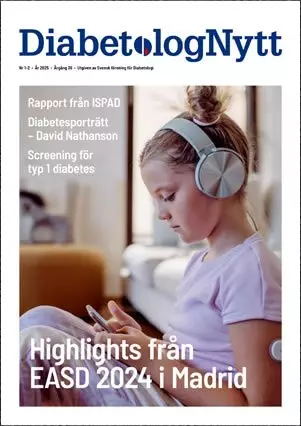First year national Swedish paediatric Hba1c data are at the level of several intervention studies: Results from a Swedish nationwide diabetes register study
Isabelle I K Steineck 1, Johan Anderzén 2, Katarina Eeg-Olofsson 3, Jan Ekelund 4, Soffia Gudbjörnsdottir 4, Lena Hanberger 5, Jonatan Nåtman 4, Auste Pundziute Lyckå 6, Ulf Samuelsson 7, Stefan Särnblad 8, Karin Åkesson 9, Ragnar Hanas 10
Affiliations
- PMID:39117042
- DOI:10.1016/j.diabres.2024.111807
´Diabetes Res Clin Pract
. 2024 Aug 6:111807.
doi: 10.1016/j.diabres.2024.111807.Online ahead of print.
Abstract
Aims/hypothesis:
To study the progression of HbA1c after diagnosis of type 1 diabetes in children and adolescents during 2010-2019 with emphasis on HbA1c nadir 3-6 months after onset.
Methods:
Partial funding was secured for this study. The Swedish paediatric diabetes quality register SWEDIABKIDS has >95 % coverage of type 1 diabetes up to 18 years. A mixed model for repeated measurements was used to estimate differences in HbA1c between onset year periods.
Results:
We followed 6,891 patients over two years from onset (48,292 HbA1c values). We found a gradual decrease in mean HbA1c 24 months after onset from 56.0 mmol/mol (7.28 %) in 2010/11 to 50.5 mmol/mol (6.77 %) in 2018/19, which is at the level of several recent intervention studies.
The initial drop in HbA1c from onset until 3 and 6 months has become more pronounced in recent years. There was a significant positive correlation between HbA1c at 3 and 6 months with 12, 18 and 24 months.
Percentage of severe hypoglycaemic coma was higher (5.1 % vs 3.4 %; p = 0.023) in 2010/2011 than 2018/2019, but the absolute risk of ketoacidosis was essentially unchanged, (1.5 % to 0.8 %, p = 0.110) Conclusions/interpretation. There was a continuous decrease in HbA1c over the study period 2010-2019, which coincides in time with an increased use of diabetes technology and lowering the HbA1c target to 48 mmol/mol (6.5 %).
The decrease in 2-year HbA1c was preceded by a lower HbA1c nadir, which may set the trajectories for coming HbA1c and be a modifiable factor for a long-term improvement in metabolic control.
Läs hela artikeln free pdf
https://www.diabetesresearchclinicalpractice.com/article/S0168-8227(24)00717-4/fulltext
From the rticle
1. Introduction
Balancing insulin requirements in children and adolescents with type 1 diabetes, whether through injections or pump therapy, while avoiding hyperglycaemia and hypoglycaemia, remains a significant challenge. Nevertheless, maintaining normoglycemia offers substantial benefits, including a reduced risk of diabetes-related complications. There is a large variation in mean HbA1c levels during childhood between high-income countries However, a similar increase in mean HbA1c occurs in all countries from childhood to adolescence [
In Sweden, the procedure at diabetes onset traditionally involves hospitalized care for between one and two weeks, with education and information according to national guidelines based on the International Society for Paediatric and Adolescent Diabetes (ISPAD) guidelines [
The diabetes care for children and adolescents in Sweden is predominantly provided by paediatric diabetologists, with support from a multidisciplinary team including diabetes nurses, dietitians, and psychologists. Treatment was intensified in Sweden, including implementations of carbohydrate counting and focus on treatment target to normoglycemia from the diabetes onset, with nationwide quality improvement collaboratives during the years 2011 to 2014, and the use of diabetes technology in the form of insulin pumps and continuous glucose monitoring (CGM) increased considerably. There has been a continuous decrease in paediatric HbA1c levels in recent years, and HbA1c level at paediatric clinics in Sweden is among the lowest in the world, both in children and adolescents It is reasonable to assume that metabolic control in children and adolescents depends on both psychosocial, environmental, and biological factors as well as the medical care. One factor may also be how the approach and expectations from the healthcare team, especially during the first months after diagnosis, affect glycaemic control in children and adolescents. Another important factor is the HbA1c target which ISPAD lowered from 58 to 52 mmol/mol (7.5 to 7.0 %) in 2018 . The United Kingdom had already in 2015 lowered their target for both paediatric and adult practice to 48 mmol/mol (6.5 %) with reference to the Diabetes Control and Complications Trial (DCCT) where this resulted in the lowest risk of complications. A transition to lower childhood HbA1c target was initiated by the Swedish childhood diabetes teams as a part of their ongoing quality improvement initiative, and both targets 57 and 52 mmol/mol (7,4 and 6,9%) were used in annual reports of the childhood diabetes register during 2013–2016. The HbA1c target for children and adolescents in Sweden was then further lowered from 52 to 48 mmol/mol (7.0 to 6.5 %) in April 2017, but many clinics had already begun to apply this lower target from the second half of 2016.
In this study, our primary aim was to investigate if HbA1c during the first two years after diabetes onset in children and adolescents differed over time between 2010 and 2019. The hypothesis was that the change had been established rather early, within the first year after the onset, because of intensified early treatment, reflected as a gradual decrease in HbA1c nadir at 3 to 6 months after onset. Our secondary aims were to investigate how body mass index (BMI), diabetes ketoacidosis (DKA), and severe hypoglycaemic coma have developed over these years with decreased HbA1c. Ethical approval was obtained from the Swedish Ethical Review Authority, diary number 2019–03600.
Läs hela artikeln free pdf
https://www.diabetesresearchclinicalpractice.com/article/S0168-8227(24)00717-4/fulltext
Nyhetsinfo
www red DiabetologNytt





